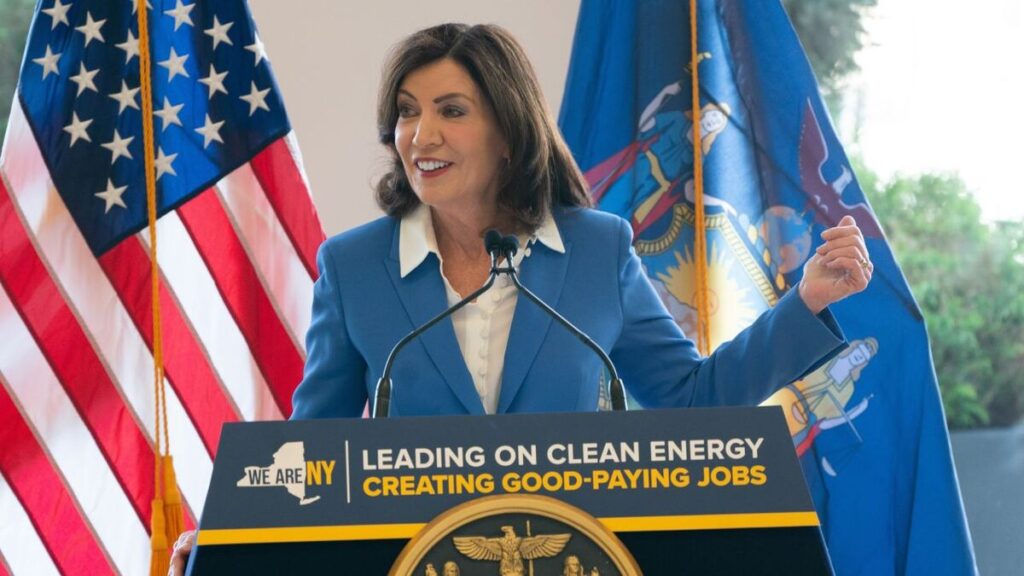New York Announces Largest State Investment in Renewable Energy in U.S. history

|
Listen to this story:
|
- Three Offshore Wind and 22 Land-Based Renewable Energy Projects Totaling 6.4 Gigawatts Will Power 2.6 Million New York Homes and Deliver 12 Percent of New York’s Electricity Needs in 2030
- Projects Expected to Create Approximately 8,300 Family-Sustaining Jobs and Bring $20 Billion in Economic Development Investments Statewide, Including Developer-Committed Investments to Support Disadvantaged Communities
- Advances the Nation’s First Offshore Wind Blade and Nacelle Manufacturing Facilities with the State Committing $300 Million and Attracting an Additional $668 Million in Private Funding
- Supports Progress Toward New York’s Climate Act Goal to Obtain 70 Percent of the State’s Electricity from Renewable Sources by 2030
- 79 Percent of New York’s 2030 Electricity Needs to be Met with Renewable Energy
New York Governor, Kathy Hochul, announced the largest state investment in renewable energy in United States history, demonstrating New York’s leadership in advancing the clean energy transition.
The conditional awards include three offshore wind and 22 land-based renewable energy projects totaling 6.4 gigawatts of clean energy, enough to power 2.6 million New York homes and deliver approximately 12 percent of New York’s electricity needs once completed. When coupled with two marquee offshore wind blade and nacelle manufacturing facilities, this portfolio of newly announced projects is expected to create approximately 8,300 family-sustaining jobs and spur $20 billion in economic development investments statewide, including developer-committed investments to support disadvantaged communities.
Related Article: NY Fed Urges Electrification of Small Multifamily Buildings to Meet Clean Energy Goals
The announcement supports progress toward New York’s goal for 70 percent of the state’s electricity to come from renewable sources by 2030 – and nine gigawatts of offshore wind by 2035 – on the path to a zero-emission grid as required by the Climate Leadership and Community Protection Act. Following these awards, New York will now have enough operating, contracted, and under development renewable energy projects to supply 79 percent of the state’s 2030 electricity needs with renewable energy.
“New York continues to set the pace for our nation’s transition to clean energy,” Governor Hochul said. “An investment of this magnitude is about more than just fighting climate change – we’re creating good-paying union jobs, improving the reliability of our electric grid, and generating significant benefits in disadvantaged communities. Today, we are taking action to keep New York’s climate goals within reach, demonstrating to the nation how to recalibrate in the wake of global economic challenges while driving us toward a greener and more prosperous future for generations to come.”
U.S. Secretary of Energy Jennifer M. Granholm said, “The Department of Energy applauds the significant step that this announcement represents for building an offshore wind energy industry here in the U.S. that revitalizes domestic manufacturing and coastal economies, while advancing our clean energy future. New York is showing President Biden’s Investing in America agenda at work, and DOE looks forward to continued collaboration on project deployment, development of a robust domestic supply chain along with transmission development to help realize both our state and federal offshore wind goals.”
Once in service, the awarded offshore wind and land-based renewable energy projects will:
- Produce approximately 19 million megawatt-hours of new renewable energy per year, enough to power more than 2.6 million New York homes.
- Reduce greenhouse gas emissions by 9.4 million metric tons annually, the equivalent of taking more than 2 million cars off the road every year.
- Provide public health benefits resulting from reduced exposure to harmful pollutants—including fewer episodes of illness and premature death, fewer days of missed school or work, less disruption of business, and lower health care costs.
- Deliver a host of benefits to disadvantaged communities in line with the Climate Act goals, with over $3.5 billion in commitments to disadvantaged communities made by developers.










